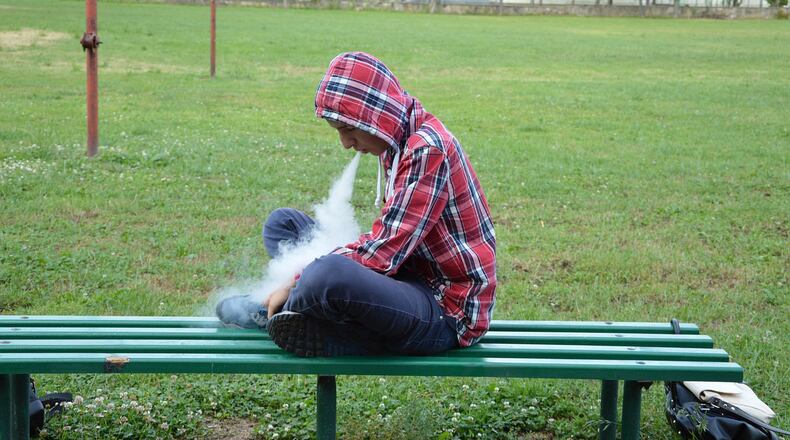An annual tracking of drug use by U.S. adolescents shows that 8th, 10th and 12th graders are increasingly combining vaping and pot.
The Monitoring the Future study, which has tracked substance use outcomes since 1975 for 12th graders and since 1991 for 10th and 8th graders, documents a surge in marijuana vaping from 2018 to 2019. The increase ranked among the largest single-year jumps ever observed by the researchers in the 45 years of the tracking study.
The annual audit of adolescent drug use also confirms what schools across Georgia are seeing; the percentage of students who report vaping nicotine in the past month more than doubled for all three grades surveyed over the last two years, rising from 11% to 25.5% among 12th graders, from 8.2% to 19.9% among 10th graders, and from 3.5% to 9.6% among 8th graders. Among high school seniors, 11.6% report vaping nicotine on a near-daily basis.
This rise in vaping comes at a time when prescription opioid misuse, tobacco cigarettes smoking and alcohol use by teens are declining, according to the study.
Last month, the American Medical Association called for an immediate ban on all electronic cigarettes and vaping devices in light of an outbreak of lung disease linked to vaping.
"The 2019 Monitoring the Future survey results released today confirm that the youth e-cigarette epidemic has gotten even worse this year and underscore why policy makers at all levels must act now to eliminate the flavored products that are luring and addicting our kids. This survey also provides troubling new evidence that e-cigarette and vaping products are setting back the nation's overall effort to reduce youth use of addictive substances," said Matthew L. Myers, the president of the Campaign for Tobacco-Free Kids
Conducted by researchers at the University of Michigan and funded by the National Institute on Drug abuse, the report found:
In 2019 the percentage of adolescents who had vaped marijuana in the last 12 months was 21% in 12th grade, 19% in 10th grade, and 7% in 8th grade.
In 12th grade the prevalence of marijuana vaping increased 7.7 percentage points in 2019, which is the second largest increase in 12-month substance use ever recorded in this grade (The largest increase was last year, with the 10.9% absolute increase in nicotine vaping).
In 10th grade the increase was 7.0 percentage points in 2019, which is also the second largest ever observed in the 29 years that the study has tracked past 12-month substance use in this grade (the largest increase was last year, with the 8.9% absolute increase in nicotine vaping from 2017 to 2018).
For all secondary students the increases in marijuana vaping translate into at least one million additional marijuana vapers in 2019 as compared to 2018.
Nicotine vaping in the last 12 months also significantly increased this year.
In 12th grade 35% of students reported vaping nicotine in the last 12 months, a significant increase of 5.6 percentage points from last year.
In 10th grade 31% of students reported vaping nicotine in the last 12 months, a significant increase of 6.1 percentage points from 2018. And in 8th grade 17% reported vaping nicotine in the last 12 months, which is a significant increase of 5.6% from last year.
“Current policies and procedures to prevent youth vaping clearly aren’t enough,” said Richard Miech, the lead investigator of the project, in a statement. “We need new policies and strategies to prevent unscrupulous businesses from making billions of dollars by addicting children to nicotine. Because the vaping industry is quickly evolving, new, additional, vaping specific strategies may well be needed in the years to come in order to keep vaping devices out of the hands of youth.”
The findings align with the 2019 National Youth Tobacco Survey, which uncovered a surge in youth e-cigarette use in the past two years. That survey revealed that 27.5% of high school students and 10.5% of middle school students now use e-cigarettes.
“These survey results put policy makers on notice that they will be held responsible if they fail to take the bold action needed to reverse this epidemic and prevent e-cigarettes from addicting a generation of kids. The Trump Administration, Congress and states and cities must act now to prohibit the flavored products that are fueling this crisis,” said Myers.
About the Author
Keep Reading
The Latest
Featured


